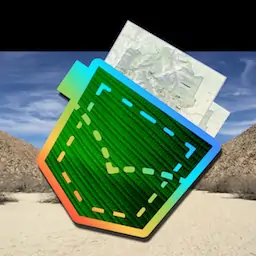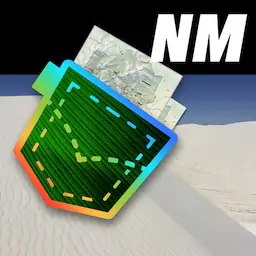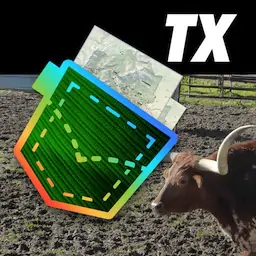"White dune landscape, White Sands National Monument, 2016." by U.S. National Park Service , public domain
Activity BookJunior Rangers |
Junior Dunes Ranger Activity Book for White Sands National Park (NP) in New Mexico. Published by the National Park Service (NPS).
White Sands
National Park Service
U.S. Department of the Interior
White Sands National Park
Junior Dunes Ranger Activity Book
I 3
WHSA!
NPS
Become a Junior Dunes Ranger!
Hi!
Welcome to White Sands, friends! My
name is Riley, and I am excited to share my
favorite place with you today. We are going
to have a great adventure exploring and
learning about White Sands, the world’s
largest gypsum dunefield. My book has
activities that are especially made for you
depending on your age.
Kit Fox: Ages 6-8
Jackrabbit: Ages 9-12
Bobcat: Ages 13 and up
When you are finished with your activities, please return your book to a
park ranger in the visitor center to be sworn in as an official White Sands
Junior Dunes Ranger! If you have any questions, please ask a park ranger.
Let’s explore White Sands!
Parents: This is a family program. Feel free to help your aspiring Junior
Ranger. We hope that your whole family learns about the park.
Are you on a tight timeline and can’t return your book today? Not a problem. Mail
in your book to the address below and a ranger will take a look at it.
Address: White Sands NP, PO Box 1086, Holloman AFB, NM 88330.
Recording Your Memories
As you explore White Sands, write or draw something in the journal
below that you will want to remember about your visit today.
3
Having Fun and Being Safe
Leave No Trace
Safety Tip!
Lightning can
strike up to ten
miles away from
a storm. When
thunder roars,
go indoors!
4
Riley loves being outside and having fun! She knows the best way to enjoy
White Sands is to follow a few safety tips. Find and circle all the safe ways
Riley and her friends are enjoying the dunes in the image below.
Riley’s safety tips:
Drink lots of water
Be prepared for your hike
Throw away trash in a trash can
Keep pets on a leash
Wear a hat, sunscreen, & sunglasses
Hike with a friend
5
Solving Riley’s Riddles
Riley wrote a few riddles about her friends. Use the pictures below to help
solve Riley’s riddles. Fill in the blank with the number of the animal below
that matches the riddle.
My blood is cold, my rattle bold
If I’m in sight, stay clear! I bite!
But worry not; the taste I’ve got
Is for eggs, small birds, and mice.
By day I sleep, by night I creep
To gather my favorite seeds.
I blend in at night to avoid any fights –
White fur makes me hard to see!
Who am I?
Who am I?
Eight legs have I, eight eyes to spy,
A trail my spinner leaves.
My fangs are meek, and only seek
To munch bugs smaller than me.
White I am not, so I’m easy to spot
As I crawl along the sand.
Stink I have plenty, so don’t try to pet me!
Respect I must command.
Who am I?
Who am I?
My beak is long, it’s very strong,
Just ask the food I eat.
I can fly up in the sky,
And run fast on my feet
My ears are pointy, tipped with black;
For my short tail I’m named.
I leave no claw marks in my track;
As a stealthy hunter I’m famed.
Who am I?
Who am I?
1. Western Diamondback Rattlesnake
4. Darkling Beetle
6
2. Bobcat
3. Greater Roadrunner
5. Apache Pocket Mouse
6. Tarantula
Be a Park Ranger
Riley has a lot of park ranger friends, and each one of them has a different
reasons why they decided to become a park ranger.
What does being a park ranger mean to you? Write you respose below.
Riley knows she is in a national park when she sees the National Park Service
arrowhead. Have you seen an arrowhead? If not, look around the visitor
center or on the front cover of this book.
Each of the pictures in the arrowhead, like the mountain, mean something
important. Draw your favorite part of the arrowhead below. Why did you
choose to draw that item? Write your response next to the arrowhead.
7
Dining in the Desert
A food chain shows how each living thing gets its food. Some animals eat
plants, and some animals eat other animals. Plants are called producers
because they combine sunlight, water, and carbon dioxide in a process
called photosynthesis. Through photosynthesis, plants produce oxygen and
carbohydrates—a simple sugar (food). Animals cannot make their own food
so they must eat plants and/or other animals. They are called consumers.
Consumers come in three tiers, primary, secondary, and tertiary. Primary
consumers eat only plants (herbivore). Secondary consumers can eat both
plants and other animals (omnivore). Tertiary consumers eat only other
animals (carnivore). Then there are decomposers (bacteria and fungi) that
feed on decaying matter.
Unscramble the letters to fill in the blanks with the correct word. Use the
word bank on the right if you need help.
Soil, _________________, (aibctera) and fungi capture nitrogen from the air
and make it ________________ (busela) for plants. Otherwise, most desert
plants could not grow.
Plants like the _______________ (uyacc) and ________________ (nidain) rice
grass provide food and shelter for moths, ants, ______________ (orgaknoa)
rats, Apache _________________ (oktpce) mice, and other animals. These
plants are called ________________ (rmpiyar) producers because all life on
the dunes _________________ (pnededs) on them.
Spiders, _________________ (cropsonsi), and lizards eat insects.
Badgers, _________________ (eyscoto), kit foxes, and snakes eat mice and
other _______________ (stderon).
8
Tertiary Consumers
American Badger
Secondary Consumers
Western Diamondback
Rattlesnake
Loggerhead Shrike
Primary Consumers
Kangaroo Rat
Black Tail Jackrabbit
Apache Pocket Mouse
Producers
Indian Rice Grass
Skunk Bush Sumac
Soaptree Yucca
Decomposers
Fungi
Word Bank:
usable
yucca
bacteria
rodents
scorpions
coyotes
pocket
depends
primary
indian
kangaroo
Darkling Beetle
Cyanobacteria
What would happen to the badger population if the
pocket mouse and kangaroo rat caught a disease and
many of them died?
9
Transforming Rock into Sand and Dunes
Riley has a question for you. Where did all this gypsum sand come from?
This activity will help you answer Riley’s question.
Take a look at the exhibits in the museum and label the three white arrows on
the map below as either water or wind.
Draw a selenite crystal
10
Draw coarse sand
Draw fine sand
Looking at a map of Dunes Drive below, label the map using the
numbers next to the words below.
Word Bank:
1.Playa Trail
4.Alkali Flat Trail
2.Interdune Boardwalk
5.Amphitheater
3.Dune Life Nature Trail
6.Backcountry Trail
N
11
Walk With Giants
20,000 years ago, camels, lions, giant ground sloths, and mammoths called
this place home. These animals are extinct, but they left their footprints
behind in the gypsum.
Draw a line from the animal on the left to its’ track on the right.
Harlan’s Ground Sloth
This animal probably
looked like its modern
one humped cousin, but
with longer legs. It stood
up to seven feet tall at the
shoulder.
Ancient Camel
This carnivore was even
bigger than modern African
lions. With its long legs,
it may have run up to 30
miles per hour.
American Lion
Dire Wolf
This predator was once
one of the most common
predators in North and
South America. It preyed on
ancient sloths, camels, and
even horses.
This massive creature could
weigh as much as a semitruck. Its tusks could be up
to 16 feet long. It fed on
grasses, shrubs, and some
trees.
Columbian Mammoth
Related to modern sloths,
armadillos, or anteaters;
this strange mammal could
be 10 feet tall and weigh
over a ton.
12
Measuring Up
The Harlan’s ground sloth was a powerful animal, with strong jaws, long
claws, and bone plates under its skin that worked like armor. Preserved
footprints tell us that 11,000 years ago humans hunted these giants.
Mark your height on the ruler on the left and then draw a picture of
yourself at that height next to the giant sloth.
10 ft
3m
9
8
7
2
6
5
4
3
1
2
1
0
0
Take a walk in the sand. Look at the footprint you made. How long do
you think your footprints will remain?
13
Exploring the Soaptree Yucca
One of the most common plants at White Sands is the soaptree yucca. This
yucca is one of only four plants that can grow on the moving dunes. The
plant is able to do this because of its ability to grow through the dunes as
they move. The other amazing thing about the soaptree yucca is that every
part of the plant can be used in some way.
Riley wrote several interesting facts about the soaptree yucca below. Use
the words in bold to fill in the boxes to the right.
The yucca has beautiful white flowers that bloom after it rains. The
flowers can be eaten.
The flowers grow on flower stalks that move water through the plant.
These stalks can be used as walking sticks.
The leaves of the yucca are called bayonet leaves because they are so
sharp and pointy. The sharp tips can be used as needles.
The yucca produces thousands of seeds that provide food for mice and
other rodents. Humans can also use the seeds to make a black dye.
The taproot finds water in the gypsum to keep the plant alive. The root
can be used like a potato but make sure to remove the toxic skin.
Did you Know?
Another cool part of the soaptree is
how the plant is pollinated. Yuccas
of all types are pollinated by yucca
moths. These moths blend in to the
coloring of the flower so they can be
difficult to see.
14
Did you Know?
Moths and butterflies are
in the same order of insect
(Lepidoptera). Butterflies are
a specialized group of moths
that fly during the day.
15
Holding the Dunes Together
One of Riley’s safety tips is to drink plenty of water. Water is just as
important for the dunes as it is for us. Without water, the dunes would
blow away. Water is the glue that holds the dunes in place. Throughout a
calendar year the water goes through all steps of the water cycle.
Look at the diagram below. It shows the four major steps of the water
cycle. Label each process in the water cycle using the numbers next to the
words and then circle one or more of the processes that you observe in
the dunefield.
Word Bank: 1.collection
3.evaporation
2.precipitation
4.condensation
Precipitation - Rain or snow coming down from clouds.
Evaporation - When puddles on the ground disappear as the sun heats up the water.
Collection - Water that pools in low lying areas.
Condensation - As water evaporates, the moisture condenses and forms clouds in the sky.
16
When you are in the dunes, do the following actions and
answer the questions below.
Touch the sand on the surface. What did it feel like? Was it hot or
cold?
Dig down a few inches in the sand. What is the difference between
the top of the sand and down a few inches? What do you think
makes this difference?
Did you Know?
This illustration
shows us that
two feet below the
surface, in a low
area, you will find
our water table,
which is very
unusual for a desert.
17
Nature and Geology Checklist
This is a checklist of some of Riley’s favorite things. As you visit the park,
check off any of them that you find. Some of the critters only come out at
night so don’t be discouraged if you can’t find them all.
Mammals
Coyote
American Badger
Apache Pocket Mouse
Kit Fox
Kangaroo Rat
Blacktail Jackrabbit
Reptiles
Gopher
Snake
Bleached Earless
Lizard
Western
Diamondback
Rattlesnake
Little Striped Whiptail
Geology
Gypsum Rock
18
Plant Pedestal
Sand
Selenite
Crystal
Did you see something that’s not on the list? Draw or
describe it in the space below. Ask a ranger if they can
help identify it.
Birds
Barn Swallow
Loggerhead
Shrike
Greater
Roadrunner
Raven
Tarantula Hawk Wasp
Insects
Tarantula
Darkling Beetle
Scorpion
Cottonwood
Tree Leaf
Soaptree
Yucca
Plants
Indian Rice Grass
Skunk Bush Sumac
19
Junior Ranger Pledge
I am proud to be a Junior Ranger at
White Sands National Park. I will continue to learn
about nature, and all people, so we can work
together to protect our national parks and the
places we live.
Certificate of Achievement
This certifies that
has met the requirements of a
White Sands Junior Dunes Ranger.
Ranger Signature




